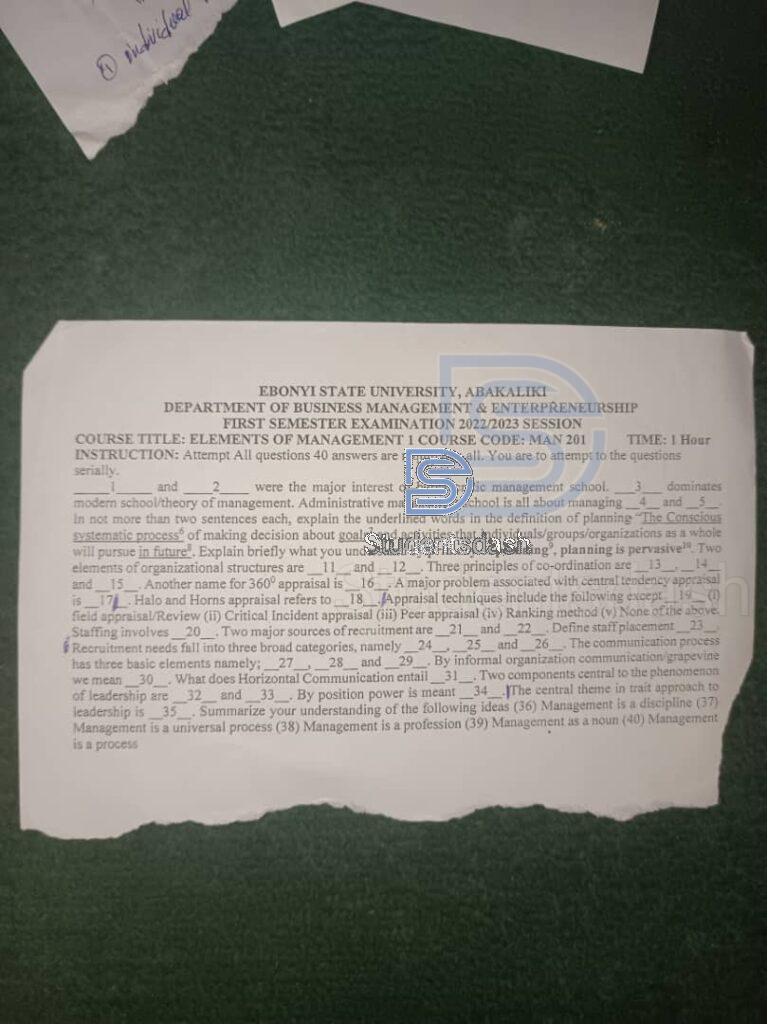Past Questions
MAN 201 Past Questions and Answers

EBONYI STATE UNIVERSITY, ABAKALIKI
DEPARTMENT OF BUSINESS MANAGEMENT & ENTREPRENEURSHIP
FIRST SEMESTER EXAMINATION 2022/2023 SESSION
COURSE TITLE: ELEMENTS OF MANAGEMENT I
COURSE CODE: MAN 201
TIME: 1 Hour
INSTRUCTION: Attempt all questions. 40 answers are required in all. You are to attempt the questions serially.
- Rules and procedures were the major interest of bureaucratic management school.
- Classical theory dominates modern school/theory of management.
- Administrative management school is all about managing organization and structure.
- In not more than two sentences each, explain the underlined words in the definition of planning – “The conscious systematic process” of making decision about goals and activities that individuals/groups/organizations as a whole will pursue in future.
- Conscious: This means that planning is deliberate and intentional, not done by accident.
- Systematic process: This implies that planning follows an organized step-by-step method.
- Goals: These are the targets or objectives that an organization aims to achieve.
- Future: Planning is forward-looking; it focuses on what will happen or needs to be achieved later.
- Explain briefly what you understand by primacy of planning, planning is pervasive:
- Primacy of planning: Planning is the first and most important function of management; it lays the foundation for all other managerial functions.
- Planning is pervasive: Planning is needed at all levels of management and in all departments.
- Two elements of organizational structures are work specialization and chain of command.
- Three principles of co-ordination are early start, continuity, and direct contact.
- Another name for 360° appraisal is multi-source feedback.
- A major problem associated with central tendency appraisal is rating everyone as average.
- Halo and Horns appraisal refers to letting one trait influence the entire evaluation.
- Appraisal techniques include the following except:
- (iv) Ranking method
- Staffing involves: recruitment, selection, training and development of employees.
- Two major sources of recruitment are: internal and external.
- The staff that placement process recruits fall into three broad categories, namely: skilled, semi-skilled, and unskilled.
- The communication process has three basic elements namely: sender, message, and receiver.
- By informal organization communication/grapevine we mean: the unofficial flow of information within an organization.
- What does horizontal communication entail?
- Communication between employees or departments at the same level of the organizational hierarchy.
- Two components central to the phenomenon of leadership are: influence and followership.
- By position power is meant: power that comes from one’s official rank or title.
- The central theme in trait approach to leadership is: inherent qualities or characteristics of a leader.
- By position power is meant: legitimate authority granted by an organization.
- The central theme in trait approach to leadership is: the belief that leaders are born, not made.
- Leadership is: the ability to influence others toward achieving group goals.
Summarize your understanding of the following ideas:
24. Management is a discipline:
- Management is a field of study with theories, principles, and practices aimed at improving organizational efficiency.
- Management is a universal process:
- Management principles apply to all types of organizations, whether private, public, small, or large.
- Management is a profession:
- Management requires specialized knowledge and training, and it follows ethical codes and standards.
- Management as a noun:
- Refers to the people or group responsible for directing and controlling an organization.
- Management is a process:
- It involves a series of interrelated functions like planning, organizing, leading, and controlling.
